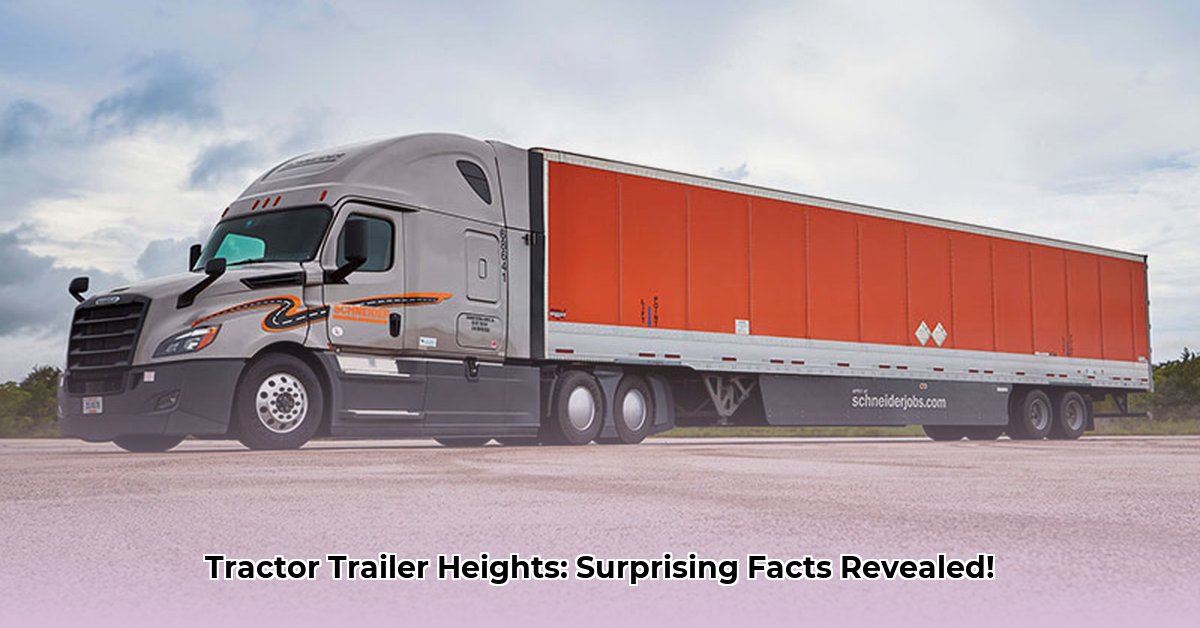
Understanding Tractor-Trailer Heights: A Crucial Aspect of Trucking
So, how tall are tractor-trailers? The answer isn't straightforward. While the maximum legal height in the US is generally 13.6 feet (4.15 meters), the actual height varies considerably. This guide will clarify the factors influencing height and provide practical steps for safe and legal operation. Ignoring height regulations can lead to costly fines and safety hazards. What crucial factors impact a semi-truck's height? For more information on other dimensions, check out our guide on tractor trailer widths.
Decoding the Height: Key Factors Affecting Tractor-Trailer Dimensions
Several factors influence a tractor-trailer's overall height:
- Trailer Type: Different trailer types (dry van, reefer, flatbed, etc.) have varying base heights. A standard enclosed dry van is typically taller than a flatbed.
- Cargo: The dimensions of the hauled cargo significantly impact the overall height. Oversized loads naturally increase the total height.
- Modifications: Added equipment like liftgates or air conditioning units can increase the truck's overall height.
- Regional Regulations: Height restrictions may vary slightly across states and even localities.
It's a common misconception that all trailers are the same height. This can lead to unexpected problems. What is the most common cause of height-related issues for truckers?
Common Trailer Types and Their Height Ranges
The following table summarizes the typical height ranges for common trailer types. Remember, these are averages; actual heights may vary:
| Trailer Type | Typical Height Range (feet) | Notes |
|---|---|---|
| Dry Van | 13.5 - 13.6 | Standard enclosed trailer for general freight. |
| Refrigerated (Reefer) | 13.5 - 14.0 | Includes refrigeration unit, adding to overall height. |
| Flatbed | 12.0 - 13.0 | Lower profile; used for oversized or unusual cargo. |
| Step Deck/Double Drop | Variable (often under 13 ft) | Multi-level decks for very tall loads; overall height may be lower, but accommodates taller cargo. |
| Specialized Trailers | Highly Variable | Numerous specialized trailers exist, each with unique height characteristics. |
Always verify the exact height on shipping documents or with the carrier. Failing to do so can have serious consequences. What percentage of trucking accidents are caused by height-related incidents?
Practical Tips for Height Awareness and Legal Compliance
Here's a step-by-step guide to ensure you're always within legal height limits:
Pre- and Post-Trip Inspections: Before every trip, visually inspect the trailer's height and double-check the paperwork. This simple check can prevent costly fines.
Route Planning with Height Restrictions: Use GPS apps designed for truckers that highlight bridges with low clearances and other height limitations. These apps can save you significant time and potential damage.
Proper Cargo Securement: Secure your load correctly. Shifting cargo can unexpectedly increase your truck's height, possibly putting you over the limit.
Clear Communication: Communicate load dimensions with shippers and receivers to ensure compatibility with height restrictions. This prevents conflicts and potential delays.
Legal Ramifications of Exceeding Height Limits
Exceeding height limits results in significant fines and potential legal issues. Staying updated on federal and state regulations is crucial. What are the average fines for exceeding height restrictions?
Calculating Exact Semi-Trailer Height for Optimal Route Planning
Accurate height calculation is crucial for efficient route planning. This involves several steps:
Identify Trailer Type and Manufacturer: Determine the base height from manufacturer specifications or documentation.
Measure Cargo Height: Accurately measure your cargo's height, accounting for any unevenness.
Account for Add-ons: Include the height of any added components (liftgates, etc.).
Calculate Total Height: Add the base trailer height, cargo height, and additional equipment heights.
Check Regional Regulations: Consult maps and relevant resources for height restrictions along your planned route.
Utilize Route Planning Software: Employ software designed for truckers to account for height restrictions. This provides a superior level of accuracy and efficiency compared to manual planning.
Manual Route Planning (If Necessary): If using software isn't possible, manually study your route, noting areas with low clearances.
Avoiding Common Pitfalls in Height Calculations
- Underestimating Cargo Height: Always add a safety buffer to account for potential variations.
- Ignoring Regional Regulations: This is a frequent source of problems; thorough research is essential.
- Improper Load Securing: Loose cargo can shift, leading to unexpected height increases.
Conclusion: The Importance of Height Awareness in Trucking
Understanding tractor-trailer heights is paramount for safe and efficient operations. Accurate height calculations, meticulous route planning, and adherence to regulations are crucial for maximizing efficiency and minimizing costs. Consistent monitoring prevents issues and enables smoother journeys.